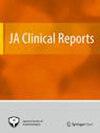在一名确诊为恶性高热的患者中使用基于雷马唑仑的全静脉麻醉:病例报告
IF 1
Q3 ANESTHESIOLOGY
引用次数: 0
摘要
恶性高热(MH)是一种罕见的、危及生命的骨骼肌细胞钙平衡失调症,由挥发性麻醉剂和琥珀胆碱引发,导致高代谢反应。致病的雷诺丁受体 1(RYR1)基因变异至关重要。对 MH 易感的患者应避免使用触发剂,最好采用全静脉麻醉(TIVA)。雷米马唑仑对疑似 MH 患者是安全的。我们介绍了首例经基因证实患有 MH 但未发展为 MH 的患者接受雷美马唑仑治疗的病例。一名有 MH 家族史的 72 岁男性接受了基于雷马唑仑的 TIVA 治疗。在获得知情同意后,进行了肌肉活检和基因检测。术中和术后,患者均未表现出 MH 征兆。RYR1 通道释放钙的功能增强,基因检测显示 RYR1 存在致病变异。在确诊为 MH 的患者中,基于雷马唑仑的 TIVA 是安全的。本文章由计算机程序翻译,如有差异,请以英文原文为准。
Remimazolam-based total intravenous anesthesia in a patient with a confirmed diagnosis of malignant hyperthermia: a case report
Malignant hyperthermia (MH) is a rare, life-threatening disorder of calcium homeostasis in skeletal muscle cells that is triggered by volatile anesthetics and succinylcholine, leading to a hypermetabolic reaction. The pathogenic ryanodine receptor 1 (RYR1) gene variant is critical. Patients susceptible to MH should avoid triggering agents, and total intravenous anesthesia (TIVA) is preferred. Remimazolam is safe in patients with suspected MH. We present the first case of remimazolam treatment in a genetically confirmed patient with MH without MH development. A 72-year-old man with a family history of MH underwent remimazolam-based TIVA. After informed consent was obtained, a muscle biopsy and genetic testing were performed. Intraoperatively and postoperatively, the patient exhibited no signs of MH. An enhanced function of the RYR1 channel into releasing calcium was indicated, and the genetic testing revealed a pathogenic variant of RYR1. Remimazolam-based TIVA is safe in patients confirming the diagnosis of MH.
求助全文
通过发布文献求助,成功后即可免费获取论文全文。
去求助
来源期刊

JA Clinical Reports
ANESTHESIOLOGY-
CiteScore
1.30
自引率
0.00%
发文量
90
审稿时长
9 weeks
期刊介绍:
JA Clinical Reports is a companion journal to the Journal of Anesthesia (JA), the official journal of the Japanese Society of Anesthesiologists (JSA). This journal is an open access, peer-reviewed, online journal related to clinical anesthesia practices such as anesthesia management, pain management and intensive care. Case reports are very important articles from the viewpoint of education and the cultivation of scientific thinking in the field of anesthesia. However, submissions of anesthesia research and clinical reports from Japan are notably decreasing in major anesthesia journals. Therefore, the JSA has decided to launch a new journal, JA Clinical Reports, to encourage JSA members, particularly junior Japanese anesthesiologists, to publish papers in English language.
 求助内容:
求助内容: 应助结果提醒方式:
应助结果提醒方式:


